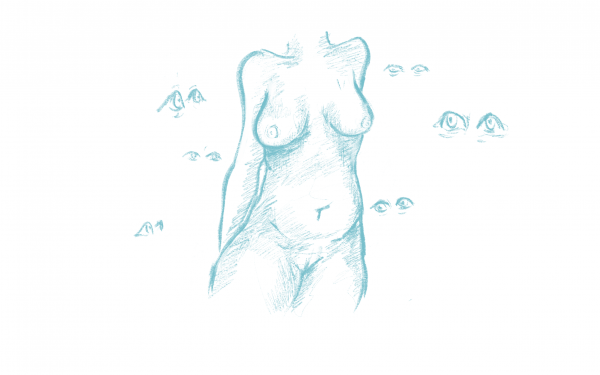Sex Ed(itorial): Fluent in Fluidity
Evolutionary insight into female sexuality
Before studying evolutionary psychology, I believed that people who claim women are more sexually fluid than men held one of three reasons.
These reasons were: women wanting to feel a part of the norm; men wanting to normalise their expectations of threesomes with two women, but not with another man; or women wanting to express their attraction to other women without facing the societal repercussions of coming out as gay.
Indeed any of these may be true, and it is true that many feminist and gender scholars view gender and sexual orientation as social constructs. However, it is also true that empirical science provides contrasting evidence.
“Pure social constructivism is... deeply problematic,” writes psychology professor Dr. Lisa Diamond in Sexual Fluidity: Understanding Women’s Love and Desire.
“As a feminist, I champion its emphasis on the social, political, and cultural factors that structure women’s experiences. Yet as a psychologist interested in the links between mind and body, I am frustrated by the fact that pure social constructionism discounts the role of bodies and biological processes in sexual experience,” she writes.
Like Diamond, I view sexual feelings and experiences as influenced by both the society around us and our biology, and that research in this area should combine the two perspectives.
Perhaps sexual fluidity in women is a conditional adaptation, like how our skin forms calluses in rough conditions but stays smooth in gentler environments—allowing for heterosexual behaviour in specific circumstances and homosexual behaviour in others.
Recent literature reflects growing recognition that male and female homosexuality may have different evolutionary origins, and the diverse forms of non-heterosexuality in women may result from specific evolutionary and developmental processes.
As defined by Diamond, sexual fluidity encompasses the range of stimuli and circumstances that evoke a sexual response in an individual.
Eye-tracking studies indicate that men often quickly focus their attention on nude images of their preferred sex, immediately identifying these images as sexual.
On the other hand, women exhibit attention towards these images related to both preferred and non-preferred sexes, perceiving both categories as sexual. In fact, most women who identify as heterosexual experience genital arousal when exposed to erotic imagery of other women.
Put simply, women exhibit greater sexual fluidity than men.
Evolutionary theorists face the task of demonstrating why a significant proportion of women experience attractions toward other women, and why these attractions may fluctuate over time within individuals.
Until around the age of 18, humans place the primary burden of their caloric expenses and development on their parents, with additional support coming from an ‘alloparenting’ network. This network includes extended family and community members who also contribute to their upbringing.
In the case of an absent or unreliable father, the child’s survival is compromised due to lesser support, and it may be beneficial for their mother to form a close relationship with another woman as opposed to raising her child alone.
Infanticide occurs frequently in nonhuman animals, as well as in humans, where a stepfather is 120 times more likely to commit infanticide than a biological father.
A woman with existing offspring would benefit from avoiding contact with other males who may commit infanticide in favour of relationships with other women, who are more likely to show a nurturing response toward her child.
In Australia, almost 37 per cent of incarcerated women identified as lesbian or bisexual, versus four per cent in the population in 2019. However, the percentage of male inmates identifying as gay or bisexual, at 5.5 per cent, did not surpass the proportion of gay and bisexual men in the general population.
Knowing this, it is fair to argue that being incarcerated isn't what leads inmates to identify as non-heterosexual. Rather, a unique blend of biological, psychological, and social factors might be linked to natural reproductive and life strategies in non-heterosexual women.
These “fast life history strategies” are characterized by energetic resource prioritization toward mating and other risky behaviours, rather than towards maintenance or parenting.
It is important to note that despite the potential costs of faster life history strategies, such as risk-taking, substance use, and poorer health outcomes, they might still make sense from an evolutionary point of view. This is because they can lead to reduced time between the birth of one child and the conception of the next child. This leads to more surviving offspring, especially in modern developed societies where child mortality is low.
Evidence from Italian and Australian studies indicate that non-heterosexual women indeed tend to have lower reproductive success compared to their heterosexual counterparts. However, the Italian study found this disadvantage can be balanced out by having more children over time.
It could also be that women are attracted to other women because there aren't strong evolutionary reasons against it. Factors like men placing low importance on intimacy and competing with other men for mates might also result in minimal pressure against genes that make women's sexual orientation flexible or changeable.
These evolutionary pressures have less effect with a fluid sexuality, but get stronger as someone leans more towards being exclusively attracted to the same sex. So, a pattern emerges where most women are mostly into the opposite sex, but a smaller group are only attracted to the same sex.
The topic of evolution and variance in human female-female sexual expression is complicated.
This is because of the lack of relevant terminology developed in many cultures and, by extension, because women having sex with women have been marginalized by historical perspectives that discredit female sexual diversity.
Here, the importance of understanding the evolutionary origins and implications of human female sexual fluidity becomes clear.
“For those of us who question, your whole life becomes a question,” writes Diamond. “Do you then reach some level of understanding, and then it's static? I don't think so.”
This article originally appeared in Volume 44, Issue 13, published April 2, 2024.

_900_900.png)
_600_832_s.png)


_600_375_s_c1.png)

_1__600_375_90_s_c1.jpg)